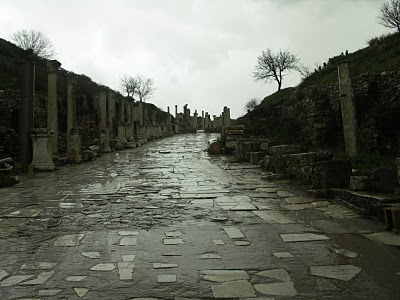After seeing the Meryemana, we drove back down the mountain to the far entrance of Ephesus.
Ephesus was first founded by Androclus, a prince of Athens, who claimed he was told where to build the city by an oracle. He also found the location of the nearby Temple of Artemis, which became one of the Seven Wonders of the Ancient World. The city itself grew so prosperous so quickly that the citizens didn’t build any defensive walls and, when they were attacked in 600 BC, they stretched a rope between the temple and the city, hoping that Artemis would protect them. Their efforts saved the temple but not the city, and Ephesus was conquered, destroyed, and rebuilt many times. Alexander the Great took control in 334 BC and left the care of the city in the hands of one of his lieutenants, who noticed that the harbour was in danger from the receding sea.
When it fell under Roman control, Ephesus became the capital of Asia Minor and grew to 250,000 people, and emperors competed with each other to make it more beautiful.
Finally, St. John brought St. Mary here to live near the end of her life, and St. Paul visited Ephesus on two missionary trips and lived here for a few years. After his ministry, the Christian population grew steadily.
The sea kept receding, though, and eventually the harbor silted in and Ephesus lost its significance.
-information taken from Lonely Planet’s Turkey guidebook, 2009
Unfortunately, the rain and hail we suffered at the Meryemana followed us all the way through Ephesus, and so we kept the camera inside our rain jackets and pulled it out for brief snapshots. These pictures are just the beginning of what there is to see, and what we missed, in this amazing city.
We entered near the Magnesia Gate and walked along the Curetes Way, one of the main smooth marble roads through the city.


This is the Great Theater, capable of seating 25, 000 people. It’s built like an IMAX theater with steep seats to improve visibility and acoustics.
This is the theater where Paul and his companions were accused of blasphemy before an angry mob of Ephesians (Acts 19:26-31).
We were there.
 This is the Sacred Way, a marble road and another one of the main streets. It had sophisticated water and sewage pipes beneath the stones.
This is the Sacred Way, a marble road and another one of the main streets. It had sophisticated water and sewage pipes beneath the stones.
 All along both sides of the roads, and in every niche and alleyway and door frame were more carvings and wells and mosaics that we couldn’t see because of the rain.
All along both sides of the roads, and in every niche and alleyway and door frame were more carvings and wells and mosaics that we couldn’t see because of the rain.
At one point, the heavens opened and a violent hail storm began. We snatched up the kids and ran with Serpil (who had no hood on her jacket!) into the entrance of the Terraced Houses, which is where the elite of Ephesus lived. The area is covered by a huge plastic roof, and we huddled at the ticket booth with a Japanese tour group until a kind Turkish security guard took us back into a private room and told us to sit near the space heater. We were rubbing Prince’s hands together, removing Princess’ soaked gloves, and debating whether we should pay the extra fee and see the Houses themselves (since we were right there), when the electricity suddenly cut out.
Serpil found out from the guards that lightning had struck a tree right outside! It was burning and damaged the power cable. Luckily, the tree was next to the police station, and the fire crew worked quickly to put out the flames.
 After about half an hour, we ventured outside in the relative stillness and trudged through lakes of hail through the rest of the city.
After about half an hour, we ventured outside in the relative stillness and trudged through lakes of hail through the rest of the city.
There were symmetrical crosses, carvings of Medusa and Hercules, and statues of local heroes and rulers, all mixed together.
Paul’s ministry here led to more than riots. Counterfeit ministries were revealed and discredited (Acts 19:13-17), people were healed through handkerchiefs and aprons merely touched by Paul (Acts 19:11-12), and people who had practiced sorcery and witchcraft publicly confessed their deeds and burned their scrolls (Acts 19:18-20).
The history of all this is carved into the very stones of Ephesus.
 This is the amazing, two-story Library of Celsus, which held 12,000 scrolls in niches around its walls. The library had two walls with a 1 meter gap between them to protect the scrolls from humidity and temperature changes.
This is the amazing, two-story Library of Celsus, which held 12,000 scrolls in niches around its walls. The library had two walls with a 1 meter gap between them to protect the scrolls from humidity and temperature changes.
 The statues are of the Virtues: Arete for Goodness, Ennoia for Thought, Episteme for Knowledge, and Sophia for Wisdom.
The statues are of the Virtues: Arete for Goodness, Ennoia for Thought, Episteme for Knowledge, and Sophia for Wisdom.

 Look at the gladiator’s helmet, leg plates, and sword! And another Crusader-type cross.
Look at the gladiator’s helmet, leg plates, and sword! And another Crusader-type cross.
These are sarcophagi along the tree-lined avenue that leads to the northern gate. St. Luke is even believed to have been buried here because of the symbol of a bull carved into a door of one of the buildings.
What a holy city.

We finally had to admit defeat and flee from dark thunder clouds that chased us out of Ephesus, all the while calling over our shoulders, “We’ll be back! We’ll be back!”
To give you an idea of what treasures still remain to be seen here, consider that there are only twelve pictures in this post, compared to the 50 sites listed in the guidebook.
No, we’re not bitter. We’re hopeful. Our chances are very good that we’ll have sunshine and blue skies in June.



